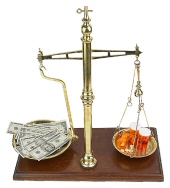Reduce Your Debt
A Practical Action Plan

Debt can be a good thing. It can help you to buy a house, invest in your education or improve your standard of living.
However, if your level of borrowing becomes excessive it can lead to many problems, such as:
- Running out of money
- Not being able to deal with unexpected costs
- Restricting your ability to take part in social activities
- Causing stress and depression
- And many more...
This article gives you some ideas on how you can reduce your personal debt. For business advice, see the article on how to reduce business debt at the Team Technology website.
Getting Control of Your Finances
There are four ways in which you can gain control of your finances and reduce your level of debt, or the monthly cost of your debt:
- Reduce what you spend
- Increase your income
- Restructure your debts (what you owe)
- Restructure your assets (what you own)
Here are some practical ideas to help you make improvements in each of these four areas:
1 Reduce What You Spend
To reduce what you spend:
- produce a list of all your items of expenditure, eg: mortgage, mobile phone bill, fuel, clothes, etc. (consult your bank and credit card statements to ensure your list is complete)
- categorise those items into:
- fixed items of expenditure (eg: mortgage)
- items that are necessary but not fixed (eg: home phone bill, fuel)
- items that are highly variable (eg: clothes, dining out, mobile phone)
Cut down, or cut out, as many items in category 3 as possible. If your level of debt is very high, try also to make as many savings in category 2 as you can, eg: start car sharing in your commute to work.
Create a budget, and stick to it.
2 Increase Your Income
To increase your income:
- Find out if you can work overtime, ask for a salary increase, or investigate other ways of increasing your income from your employer
- Consider taking lodgers into your home, or raising rent in other ways from property you own (eg: subletting)
- Consider taking an alternative job, or generating income via other ways (eg: hosting tupperware parties).
3 Restructure your debts
To reduce your debts and repayments:
- Put as much of your debt on the mortgage as possible (of all debts, the mortgage is usually the cheapest and should therefore be the last that you pay off).
- Replace existing loans with:
- loans that have a lower interest rate
- secured loans (replacing unsecured loans) to reduce the interest rate
- loans that repayments over a longer period of time
- consolidated loans (putting all your debts into one loan)
- Agree an extended repayment schedule for existing loans
- Use the 0% credit card trick to replace expensive credit card balances
Make sure you can afford new loans by producing a budget (and sticking to it!).
4 Restructure Your Assets
'Assets' are all the things you own. You can reduce the cost of your debt by:
- Down-sizing to a less expensive house
- Selling unnecessary assets (eg: reducing the number of cars in the family)
- Use savings, investments or cash to pay off outstanding loans
©2013 Team Technology. Privacy policy and cookies.

